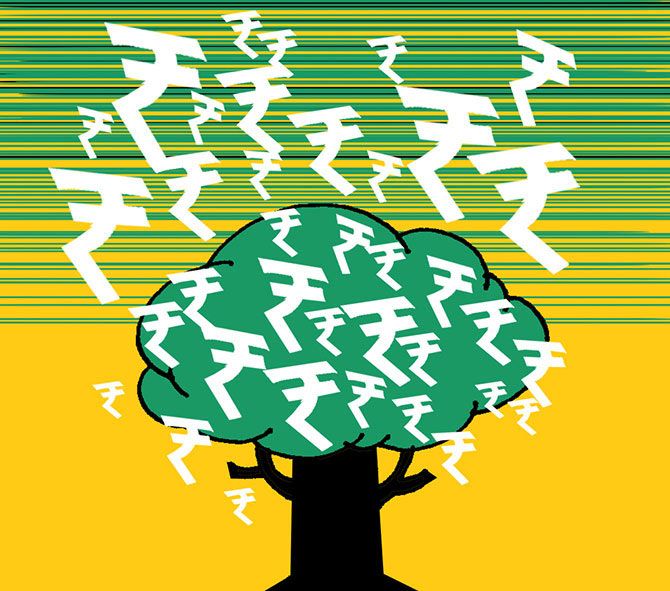‘Insularity or isolation is not the answer, as such an approach will promote neither growth nor stability.'
'India has to move vigorously to take advantage of expanding opportunities in trade and become a choice location for IT and other industries and services so that growth rates, along with employment, are substantially enhanced.’
A must-read excerpt from former RBI governor and former Rajya Sabha member Bimal Jalan’s India: Priorities For The Future.
Illustration: Dominic Xavier/Rediff.com

The change in the image and role of services has been brought about by unprecedented and unforeseen advances in computer and communication technology.
An important aspect of the ‘services revolution’ is that geography and levels of industrialisation are no longer the primary determinants of the location of facilities for the production of services.
As a result, the traditional role of developing countries is also changing -- from being mere recipients to becoming important providers of long-distance services.
From India’s point of view, some of the long-term global developments since the 1990s that provide opportunities for substantial growth are:
- The fastest-growing segment of services is the rapid expansion of knowledge-based services, such as professional and technical services.
With regard to these services, India has a tremendous advantage because of a developed structure of technological and educational institutions and lower labour costs.
- Progress in information technology is making it increasingly possible to unbundle the production and consumption of information-intensive service activities.
These activities -- research and development, computing, inventory management, quality control, accounting, personnel administration, secretarial, marketing, advertising, distribution and legal services -- are performed in all economic sectors. - Unlike most other prices, the world prices of transport and communications services have fallen dramatically over the years.
By 1960, sea-transport costs were less than a third of their 1920 level.
The cost of a telephone call fell more than tenfold between 1970 and 2000.
Moreover, the cost of communication is also becoming independent of distance; the most dramatic example in this area is, of course, provided by the Internet.
India’s geographical distance from several important industrial markets (for instance, North America) is no longer an important element in the cost structure of skill-based services. - Further, India does not necessarily have to be a low-cost producer of certain types of goods (for example, computers or discs) before it can become an efficient supplier of services embodied in them (for instance, software or music).
It is possible now to provide value-added services without waiting to ‘catch up’ in technology for the production of sophisticated equipment or products. - The decline in the share of manufacturing in the output of rich countries implies a relative decline in their demand for industrial raw materials and fuels.
This means that the growth in the exports of developing countries now depends less on natural-resource endowments and more on efficiency in providing services and service-intensive goods.
Another important factor in India’s favour is international capital mobility and the integration of the global financial markets.
Domestic savings continue to be important for development. However, the scarcity of domestic capital is no longer a binding constraint.
The increased mobility of capital has ensured that global resources flow to countries that can show high growth and high returns.
It is feasible for India to take advantage of a virtuous circle of higher growth, higher external capital inflows, and higher domestic incomes and savings, which in turn can lead to further growth.
At the same time, it must be recognised that the ‘death of distance’ and the growing integration of global products, services and financial markets also presents new challenges for the management of the national economy -- not only in India but all over the world.
The trend towards the integration of markets, particularly financial markets, is by no means an unmixed blessing.
Unlike the old days, a heavy price may have to be paid by national economies for somnolence, sloth and non-conformity to generally accepted international norms and standards of macroeconomic management, disclosure, transparency and financial accountability.
If a country does not put its financial house in order, fresh investments, trade and technology are likely to pass it by.
Faced with this situation, only a few countries, with certain special advantages and resource endowments, may still manage to grow at an acceptable rate.
Other countries that need capital and external flows to meet their trade or current-account deficits are likely to find it increasingly difficult to meet their import requirements of essential commodities (such as oil), raw materials and machines.
Another consequence of recent global trends is the greater vulnerability of national economies to developments outside their own borders.
In addition to the direct effects (which are most visible in the volatile stock markets), the indirect effects due to ‘contagion’ can be quite serious.
A crisis in any one country or group of countries can be transmitted to other countries -- including countries that may not have any strong economic linkages with crisis-affected countries.
The lessons from the recent developments are clear.
Advances in IT, the increasing role of services, the integration of financial and capital markets and the diminished role of distance provide tremendous new opportunities for countries like India.
At the same time, like other countries, India is also subject to greater vulnerability and new risks.
Thus, at the beginning of the new century, the challenge before India is to seize the new opportunities while, at the same time, protecting the economy against unanticipated risks.
Insularity or isolation is not the answer, as such an approach will promote neither growth nor stability.
India has to move vigorously to take advantage of expanding opportunities in trade and become a choice location for IT and other industries and services so that growth rates, along with employment, are substantially enhanced.
It must also keep some safety nets handy by building a diversified and efficient financial system that would be able to aid and protect the development process at all times -- good and bad.
Can these objectives be met?
This is the real question for the future.
Excerpted from India: Priorities For The Future by Bimal Jalan, with the permission of the publishers, Penguin Random House India.










 © 2025
© 2025